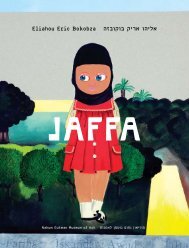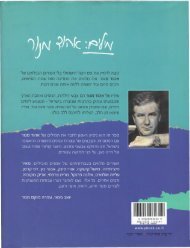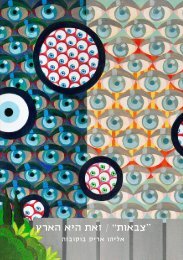eliahou eric bokobza ×ר×ק ××××× ××ק×××× eliya tsuchida ×××ת ××ר
eliahou eric bokobza ×ר×ק ××××× ××ק×××× eliya tsuchida ×××ת ××ר
eliahou eric bokobza ×ר×ק ××××× ××ק×××× eliya tsuchida ×××ת ××ר
Create successful ePaper yourself
Turn your PDF publications into a flip-book with our unique Google optimized e-Paper software.
Eliahou Eric Bokobza<br />
Little Boy<br />
“Little Boy”, translated by the artist as, “boys’ games”, deals with the process of growing<br />
up and overcoming fears. Bokobza exhibits two personal cases with a web of images that<br />
relate to the Israeli culture – a soldier, a refugee, a robot, a settler and a bomb; and the<br />
Japanese culture – a bomb, Mount Fuji, a Sequoia encapsulated in a bonsai tree, a red sun<br />
and a good luck cat. Mixed materials, a mélange of childhood memories blended in acrylic,<br />
Israeli history scrambled with Japanese history, Japanese and Israeli dolls, borrowed<br />
from his house in Tel Aviv to the Jerusalem exhibition hall.<br />
The child who drew cats<br />
A cat set in pink background - a reminder to the blossoming cherry tree, peeks from each<br />
painting. Fluffy and round like wall paper, wrapped in space suits and decorated with<br />
amulets from the Jewish and Japanese traditions. However, let us not be deceived, each of<br />
these adorable creatures conceals a tale of horror and fear. The fear of a child’s before he<br />
falls asleep, which his mother calms down with a popular Japanese legend about “the child<br />
who drew cats” . The tale’s child-hero defeats a monstrous world with cat drawings. The<br />
child-artist’s brush serves him as a weapon for overcoming fear. The fluffy cats are meant<br />
to protect him from threatening bombs, aided by the space suit coated and amulet adorned<br />
good luck cats.<br />
The work’s title, “Little Boy”, is borrowed from the past – it is the code word for the<br />
bomb that was dropped on Hiroshima. The naïve aesthetics of the titles “White Light” and<br />
“Black Rain” also conceal the memory of the bomb. The childish character of his works draws<br />
its inspiration from the paintings of Murakami Takashi, who created a similarly titled<br />
exhibition, pointing to Japan’s traumatic defeat in the war as the reason for the childish<br />
character of its culture. This childishness offers a humoristic way of dealing with the fear<br />
of loss and failure.<br />
One event mobilizes another, past connects to present in a decorative design which serves<br />
as a link between the “Middle” and the “Far” East.<br />
Robots and war<br />
Another way of coping with the horrors of war is by playing with soldiers and robots. For<br />
this end Bokobza recruits the image of the soldier in floral printed uniforms, a familiar<br />
character from his previous works. The soldier’s bullet proof vest is decorated with Israeli<br />
and biblical motifs as well as elements from the Japanese comics’ culture. The vest draws<br />
its inspiration from the sukajan, a popular jacket among young Japanese whose shape is<br />
reminiscent of a war jacket. It boasts unique embroidery prints whose origins can be found<br />
in the local culture. The jacket is a takeoff on the Am<strong>eric</strong>an army coat, worn by the soldiers<br />
who commemorated their memories in broidery.<br />
In a separate case Bokobza sets a robot doll carved from olive tree, in its center the<br />
Tower of David serves as a shield. The rest of the pictures are taken from his New Zionists<br />
project. Figures in space suits set in gold and silver plastic. Luring, flashy, dazzling<br />
objects, turn the world of war into a fantasy world, and create a disturbing gap between<br />
sweetness and the terror of war, blending local and Japanese aesthetics.<br />
25






